Continued from page 1
More Modeling and Woodworking Tools
There are a range of all new woodworking joinery tools, which are technically a modeling feature set. So before we jump into those let’s complete the notes on all the modeling improvements. The big ones were the quad mesh tools mentioned above. Smaller items include improved 3D linear duplicate for creating copies of objects in 3D space. This includes a polar array improvement too.
Advertisement
There is also the ability to independently select and modify elements within a group. This is called Deep Select. When you have a group of, say blocks, you can select them as a group with the Select tool. Using the Deep Select tool you can choose an individual block. However, if you modify a block in some way creating a secondary feature, that provokes the Select Ambiguity palette. (see images 07 – 08).
To make this a bit clearer, look at image 07 above. I have two blocks in a group. If I use the regular Select too to select a block that has a translated feature, the Ambiguity palette is provoked giving me the option of selecting the group or the translation element only. Next, if I use Deep Select, and I select the same element, I get the Ambiguity palette again but this time the group itself is not an option. This can be difficult to get use to. As it is, the Ambiguity palette (which Architosh has commended as a feature in the past) provides choices to the user. But with Select versus Deep Select, the Ambiguity palette presents different results that may throw the user off—which was clearly the case for me during this review.

07 – With Deep Select it is now possible to reach into Groups and select and modify individual objects. This adds value but there is a bit of complication. See next image.

08 – When you select objects that have been modified within a group, the Ambiguity Selection palette pops up but the ability to select the whole group isn’t an option.
I must admit I am baffled a bit by the logic of this decision as it seems to force me into the decision-making process of what selection tool to have at hand if I should want the option to select “groups” at any time. I would find the Deep selection tool more handy if the Ambiguity palette allowed me the option to choose Groups also.
Woodworking Tools
In TurboCAD Mac Pro 8, IMSI/Design has decided to create a dedicated set of woodworking modeling tools. Even though I am not a woodworker (yet!) I do know quite a bit about cabinetry being a practicing architect; therefore I was naturally interested to try these tools out. The menu for these tools doesn’t find itself in the main tool bar, but must be brought out from within the Windows menu commands. The Windows menu contains several other dedicated functional domain tools so the woodworking tools are hardly isolated and without company.
The goal of the new woodworking tools is for modeling furniture and cabinetry—in detail. TurboCAD Mac Pro 8 can easily model all the sophisticated German cabinetry hardware found in today’s modern cabinets, but what about the basic prepping of panels for the wood part of the cabinet itself? That’s what these tools are for.
With a dedicated tool for each type of joint, the new tools allow the user to quickly model a rabbet joint, dado joint, miter joint, dovetail joint, and tongue and groove type joints. Within these joint types there are several options. For instance, you can create dado joints that include stopped dados as well. Each joint type operation begins by selecting the type of joint first, then any sub-types (e.g.: dado, stopped dado or blind dado) and then selecting the parallel edges and appropriate face. Once the joint has been placed into the solid form, the user can edit its placement, width, length and other relevant dimensional features. (see images 09 – 10)
AEC Features
We have not yet spoken about any AEC (architecture, engineering, construction) features in this release yet. Version 8 actually does’t introduce any new features specifically made for this market segment; however it is warranted that we at least recap those features that apply to both MCAD and AEC.
We have mentioned in past reviews that for floor plan work the 2D features of TurboCAD are quite solid. The program even has sub-layers, which is another way to organize elements within a larger element and be able to control their visibility uniquely. Some of the new features that bear on the AEC market, besides the obvious connection in the new woodworking joinery tools, include the 3D Linear Duplicate tool, which would be useful for spiral stairs and the like.
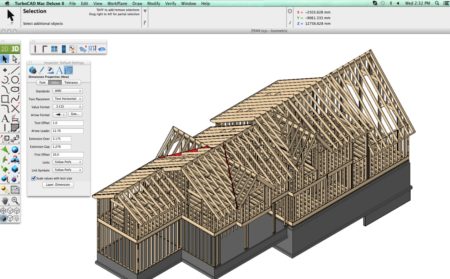
11 – TurboCAD Mac Pro 8 as an ACIS-based solid’s modeler can model just about anything, architecture included. The program features many parametric tools for AEC, and new Cut List BOMs are useful to builders and design-builders.
More importantly, perhaps, the visualization rendering updates, which will be discussed in a moment, are also of value to the AEC TurboCAD Mac Pro 8 user. So too are the general performance, 64-bit support, DWG/DFX compatibility and even the 3D printing features.
There is one feature though, that bears importance to builders in AEC in particular, and that is the new Cut List BOMs. Users can now assign cut list properties (description, QTY, length, width, thickness) to a BOM (bill of materials) and the program comes with predefined BOM templates and data set tables. Objects with these assigned attributes will then display those attributes in a BOM placed into the drawing file. In the model image show above (image 11) all the framing members can be accounted for with a Cut List BOM.
Other Features and Closing Remarks
As this review was going to press, IMSI/Design told us that TurboCAD Mac Pro 8 will soon have an optional add-on pack named PowerPack for TurboCAD Mac, coming in May, the company estimates. This PowerPack is not shipping now, of course, but its features warrant quick mention.
PowerPack will extend the 3D associated with advanced modeling, including 3D printing, mesh verification and repair, and conversion of meshes to precise solids (analytics/NURBS). It will be possible to do precise coordinate comparison between mesh and NURBS. The user will also be able to separate, combine, weld and compact meshes. We can’t factor this unshipping product into our current view but it deserves mentioning.
Mac users may also like to know that this version is based solely on Apple Cocoa compiled code and Apple CoreGraphics. Prior to this IMSI/Design used the Apple Carbon API framework. Carbon, if you recall, was the API that allowed a simpler path forward to OS X that would allow apps to run on Mac OS 8 and 9 in addition to new OS X.
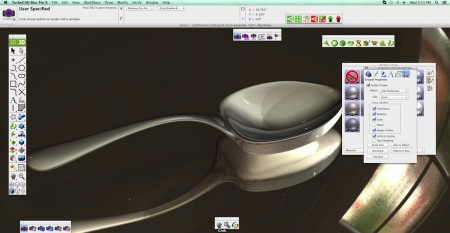
12 – Rendering capabilities have improved in TurboCAD Mac Pro 8. HDRI, new Global Illumination and several smaller improvements make it possible to output poster-size visuals ready or web or print.
TurboCAD Mac Pro 8 also includes an array of rendering and presentation improvements. The program now supports special lighting effects—including lens flares—and has GI (global illumination) lighting options. (image 12) HDRI (high dynamic range images) are also now supported, which can significantly improve the rendered images the program produces. (see rendering of the spoon above, image 12). For presentation, the ability to print poster-size renders is now possible because the program will output very large resolution images. And it’s now possible—thanks to QuickTime—to capture audio and record the screen so users can create videos and tutorials of their work.
Finally, AutoCAD file import/export support is updated to version 2013/2014, and there are improvements to STL support in the area of 3D printers. TurboCAD Mac Pro 8 also includes updated support for 3Dconnexion’s SpaceMouse using the latest drivers.
Recommendations
At a moment in time when the Mac side of the MCAD market is starting to really blossom with both end-user interest (in working on Mac) and with developers meeting that interest (in providing new software tools), we see in the new TurboCAD Mac Pro 8 a solid range of improvements to an already very solid product. With the upcoming PowerPack add-on product, TurboCAD Mac Pro 8 offers a huge value in the general mechanical CAD domain (MCAD), offering a low-end CAD product price with mid-level MCAD capabilities.
Advertisement
On a more critical note, we missed not seeing any big new AEC tools in this release. We are not sure where IMSI/Design intends to take AEC features with this product. The Windows version, which is a more advanced and costly product and competes directly in the AutoCAD space, has Industry Foundation Class (IFC) file support for Building Information Modeling (BIM). A hot area for the CAD industry is in the “maker market” and small-scale industrial design and manufacturing—including additive manufacturing. Depending on how IMSI/Design sees this product’s growth story, they may indeed shift more focus on MCAD. That’s an open question.
For this moment, TurboCAD Mac Pro 8 is an accomplished ACIS-based 2/3D CAD system that has the flexibility to be a top choice for the mid-range CAD market, including AEC, MCAD, the “maker market” and industrial design. The new Woodworking Joinery tools are really quite useful and work efficiently. We could see that area expanding a bit for workshop folks and further potential in the digital tooling (CNC) space. Finally, for those who already use this program, this is a no-brainer update—the 64-bit support, native Cocoa code base which makes the program much more robust, much greater file size support, and rendering improvements all amount to good value. —– ANTHONY FRAUSTO-ROBLEDO, AIA, LEED AP.
Pros: very robust ACIS-based 3D CAD modeling; new quad mesh and subdivision surfaces modeling adds expanded capability in areas of product design, industrial design and complex surface creation; convert mesh to solids for 3D printing feature, solid 3D printing support; built-in rendering gains new GI (global illumination) and HDRI support; truly 64-bit down to core components (e.g.: ACIS R24) including OS X native Cocoa code base, unlimited model/file sizes, etc.; program has excellent viewport UI controls for flexible windowing, viewport auto-generation of 3D models from AutoCAD files, flexible tear-out tool palettes, etc.; superb import/export file options.
Cons: Even as a mid-level CAD tool, the AEC side of program could benefit from BIM interoperability options such as IFC or Revit interoperability. New woodworking tools point towards sub-contractor CAD market, yet they too must plug-in to total AEC workflow pipeline for increased AEC interoperability.
Advice: the program is stronger as a MCAD tool than an AEC CAD tool, despite many good AEC features, including interoperability with Rhino and SketchUp (the two leading modelers currently in the architectural market). For shops feeding the AEC stream with product, TurboCAD Mac Pro 8 is a very solid contender. For “makers” and small shops, product design and MCAD folks, at this mid-level price range TurboCAD Mac Pro 8 is a “must consider” product on the Mac platform.
Cost: 499.95.USD (new license) IMSI/Design

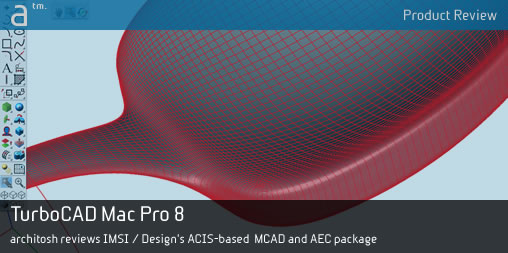
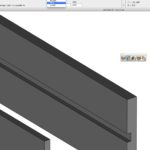
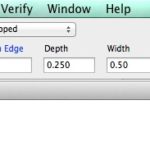


Reader Comments
Architosh reviews the latest version of IMSI/Design’s TurboCAD Mac Pro 8. Since 2006 the company returned to the Mac…https://t.co/o9Rb8ljXK4
Architosh reviews the latest version of IMSI/Design’s TurboCAD Mac Pro 8. Since 2006 the company returned to the Mac…https://t.co/o9Rb8ljXK4
Architosh reviews the latest version of IMSI/Design’s TurboCAD Mac Pro 8. https://t.co/8htTlG9K7F @architosh
Architosh reviews the latest version of IMSI/Design’s TurboCAD Mac Pro 8. https://t.co/8htTlG9K7F @architosh
IMSI Design #TurboCAD Mac Pro 8 http://t.co/k1nQVbnUyI by Anthony Frausto-Robledo #cad #mcad
IMSI Design #TurboCAD Mac Pro 8 http://t.co/k1nQVbnUyI by Anthony Frausto-Robledo #cad #mcad
RT @architosh: Product Review: IMSI Design TurboCAD Mac Pro 8: It has been over a year and a half since we last reviewed … http://t.co/Q5…
RT @architosh: Product Review: IMSI Design TurboCAD Mac Pro 8: It has been over a year and a half since we last reviewed … http://t.co/Q5…
I think you mean that TurboCAD is Core Profile OpenGL based, not CoreGraphics.
@ cgbeige,
Actually, while TurboCAD is OpenGL based, I did in fact mean to refer to Apple Core Graphics (CoreGraphics), which is synonymous with Quartz (graphics layer). This app used to contain Carbon API code but is now fully Cocoa based. I suppose, and I’m guessing here, that IMSI/Design used Metrowerks’ PowerPlant IDE (integrated development environment) at one time. During app crashes if one looks at thread data on crashes you can often spot PowerPlant in the code lines. This was the old Carbon framework that saved Apple in the late 90’s and helped them jump from Classic to OS X (PowerPC only). Metrowerks PowerPlant for Mac vanished once Apple introduced OS X on Intel and Xcode, it’s own development tool.
The Carbon API is deprecated by Apple but is present, I’m fairly certain, even in Yosemite. I personally suspect some larger legacy apps with remaining Carbon code crash more frequently than they should now due to Carbon but I’m speculating. IMSI’s TurboCAD Mac Pro 8 ran solid the entire time (zero crashes) and it’s now fully Cocoa based.
I think you mean that TurboCAD is Core Profile OpenGL based, not CoreGraphics.
@ cgbeige,
Actually, while TurboCAD is OpenGL based, I did in fact mean to refer to Apple Core Graphics (CoreGraphics), which is synonymous with Quartz (graphics layer). This app used to contain Carbon API code but is now fully Cocoa based. I suppose, and I’m guessing here, that IMSI/Design used Metrowerks’ PowerPlant IDE (integrated development environment) at one time. During app crashes if one looks at thread data on crashes you can often spot PowerPlant in the code lines. This was the old Carbon framework that saved Apple in the late 90’s and helped them jump from Classic to OS X (PowerPC only). Metrowerks PowerPlant for Mac vanished once Apple introduced OS X on Intel and Xcode, it’s own development tool.
The Carbon API is deprecated by Apple but is present, I’m fairly certain, even in Yosemite. I personally suspect some larger legacy apps with remaining Carbon code crash more frequently than they should now due to Carbon but I’m speculating. IMSI’s TurboCAD Mac Pro 8 ran solid the entire time (zero crashes) and it’s now fully Cocoa based.
Archaeology and Modernity free downloads
Review’A work that will undoubtedly become a modern masterpiece… Archaeology and Modernity is one of the most powerful archaeology books I know. It promises
Comments are closed.